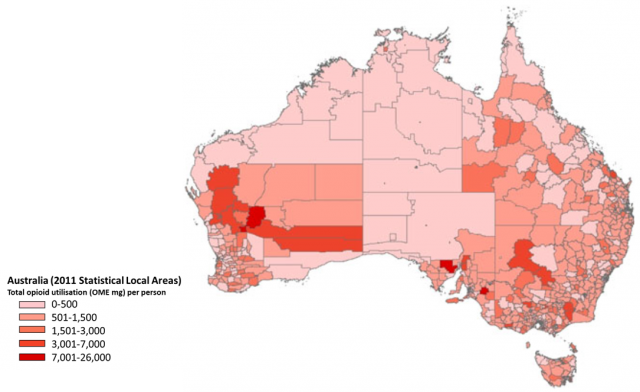Use
This section provides information about the ways in which Australians use pharmaceutical drugs. It addresses how often Australians use pharmaceutical drugs, the most common types used, and locations of use.
The primary source of data used in this section is the 2019 National Drug Strategy Household Survey (NDSHS) (Australian Institute of Health and Welfare, 2020). The NDSHS is a triennial general population survey of Australians' awareness, attitudes, and behaviours relating to alcohol and other drug use. It is one of the best data sources available to provide a national population demographic profile of Australians’ patterns of pharmaceutical drug use.
To be consistent with source terminology, FAQs which utilise NDSHS data include the following pharmaceutical drugs:
- Pain-killers/pain-relievers/opioids
- Tranquillisers/sleeping pills
- Methadone/buprenorphine.
Not all of these drugs are included in each FAQ, due to small numbers of people using some drug types, and limitations of the datasets. Footnotes have been provided in each FAQ to identify exactly which drugs are referred to and how they have been defined according to the data source.
What proportion of Australians have used pharmaceutical drugs in their lifetime?
Most Australians (68%) have used pharmaceutical drugs† in their lifetime.
Source: Australian Institute of Health and Welfare (AIHW). 2019 National Drug Strategy Household Survey (NCETA secondary analysis, 2021).
†This FAQ uses data from the National Drug Strategy Household Survey, which defines the pharmaceutical drugs referred to in this question as: the medical or non-medical use of pain-killers/pain-relievers/opioids (oxycodone, morphine, codeine products such as panadeine forte (excluding paracetamol, asprin and ibuprofen where these drugs are the only active ingredients)), tranquillisers/sleeping pills (e.g., sleepers, benzos, tranks, temazzies, temaze, rivotril, serepax, serries, xanax, xannies, stilnox, rohypnol, rowies, valium) and methadone/buprenorphine (e.g., done, junk, jungle juice, bupe, sub).
Non-medical use: A drug used:
- By itself to induce a drug experience or feeling; or
- With other drugs in order to enhance a drug experience.
Are men or women in Australia more likely to have used pharmaceutical drugs in their lifetime?
A higher proportion of Australian women (71%) have used pharmaceutical drugs† in their lifetime compared to men (65%).
Source: Australian Institute of Health and Welfare (AIHW). 2019 National Drug Strategy Household Survey (NCETA secondary analysis, 2021).
†This FAQ uses data from the National Drug Strategy Household Survey, which defines the pharmaceutical drugs referred to in this question as: the medical or non-medical use of pain-killers/pain-relievers/opioids (oxycodone, morphine, codeine products such as panadeine forte (excluding paracetamol, asprin and ibuprofen where these drugs are the only active ingredients)), tranquillisers/sleeping pills (e.g., sleepers, benzos, tranks, temazzies, temaze, rivotril, serepax, serries, xanax, xannies, stilnox, rohypnol, rowies, valium) and methadone/buprenorphine (e.g., done, junk, jungle juice, bupe, sub).
Non-medical use: A drug used:
- By itself to induce a drug experience or feeling; or
- With other drugs in order to enhance a drug experience.
Are younger or older Australians more likely to have used pharmaceutical drugs in their lifetime?
In general, older Australians are more likely than younger Australians to have used pharmaceutical drugs† in their lifetime.
Source: Australian Institute of Health and Welfare (AIHW). 2019 National Drug Strategy Household Survey (NCETA secondary analysis, 2021).
†This FAQ uses data from the National Drug Strategy Household Survey, which defines the pharmaceutical drugs referred to in this question as: the medical or non-medical use of pain-killers/pain-relievers/opioids (oxycodone, morphine, codeine products such as panadeine forte (excluding paracetamol, asprin and ibuprofen where these drugs are the only active ingredients)), tranquillisers/sleeping pills (e.g., sleepers, benzos, tranks, temazzies, temaze, rivotril, serepax, serries, xanax, xannies, stilnox, rohypnol, rowies, valium) and methadone/buprenorphine (e.g., done, junk, jungle juice, bupe, sub).
Non-medical use: A drug used:
- By itself to induce a drug experience or feeling; or
- With other drugs in order to enhance a drug experience.
What types of pharmaceutical drugs have Australians used in their lifetime?
Most Australians (65%) have used pain-killers/pain-relievers/opioids during their lifetime, and a quarter (25%) have used tranquillisers/sleeping pills. Smaller proportions have used methadone/buprenorphine (1%).
Source: Australian Institute of Health and Welfare (AIHW). 2019 National Drug Strategy Household Survey (NCETA secondary analysis, 2021).
†This FAQ uses data from the National Drug Strategy Household Survey, which defines the pharmaceutical drugs referred to in this question as: the medical or non-medical use of pain-killers/pain-relievers/opioids (oxycodone, morphine, codeine products such as panadeine forte (excluding paracetamol, asprin and ibuprofen where these drugs are the only active ingredients)), tranquillisers/sleeping pills (e.g., sleepers, benzos, tranks, temazzies, temaze, rivotril, serepax, serries, xanax, xannies, stilnox, rohypnol, rowies, valium) and methadone/buprenorphine (e.g., done, junk, jungle juice, bupe, sub).
Non-medical use: A drug used:
- By itself to induce a drug experience or feeling; or
- With other drugs in order to enhance a drug experience.
Have men and women in Australia used different types of pharmaceutical drugs in their lifetime?
Women are more likely than men to have used pain-killers/pain-relievers/opioids and tranquillisers/sleeping pills during their lifetime. The same proportion of men and women have used methadone/buprenorphine.
Source: Australian Institute of Health and Welfare (AIHW). 2019 National Drug Strategy Household Survey (NCETA secondary analysis, 2021).
†This FAQ uses data from the National Drug Strategy Household Survey, which defines the pharmaceutical drugs referred to in this question as: the medical or non-medical use of pain-killers/pain-relievers/opioids (oxycodone, morphine, codeine products such as panadeine forte (excluding paracetamol, asprin and ibuprofen where these drugs are the only active ingredients)), tranquillisers/sleeping pills (e.g., sleepers, benzos, tranks, temazzies, temaze, rivotril, serepax, serries, xanax, xannies, stilnox, rohypnol, rowies, valium) and methadone/buprenorphine (e.g., done, junk, jungle juice, bupe, sub).
Non-medical use: A drug used:
- By itself to induce a drug experience or feeling; or
- With other drugs in order to enhance a drug experience.
Have younger and older Australians used different types of pharmaceutical drugs in their lifetime?
Pharmaceutical drug† use is generally more likely among older age groups. The most commonly used pharmaceutical drugs in all age groups are pain-killers/pain-relievers/opioids, followed by tranquillisers/sleeping pills.
Source: Australian Institute of Health and Welfare (AIHW). 2019 National Drug Strategy Household Survey (NCETA secondary analysis, 2021).
†This FAQ uses data from the National Drug Strategy Household Survey, which defines the pharmaceutical drugs referred to in this question as: the medical or non-medical use of pain-killers/pain-relievers/opioids (oxycodone, morphine, codeine products such as panadeine forte (excluding paracetamol, asprin and ibuprofen where these drugs are the only active ingredients)), tranquillisers/sleeping pills (e.g., sleepers, benzos, tranks, temazzies, temaze, rivotril, serepax, serries, xanax, xannies, stilnox, rohypnol, rowies, valium) and methadone/buprenorphine (e.g., done, junk, jungle juice, bupe, sub).
* Estimate has a relative standard error of 25% to 50% and should be used with caution.
** Estimate has a relative standard error greater than 50% and is considered too unreliable for general use.
Non-medical use: A drug used:
- By itself to induce a drug experience or feeling; or
- With other drugs in order to enhance a drug experience.
Does lifetime pharmaceutical drug use in Australia vary by geographic location?
Lifetime use of pharmaceutical drugs† tends to be slightly higher in inner regional areas, compared to major cities and outer regional/remote/very remote locations. The exception to this is methadone/buprenorphine use, which is relatively similar across geographic locations.
Source: Australian Institute of Health and Welfare (AIHW). 2019 National Drug Strategy Household Survey (NCETA secondary analysis, 2021).
†This FAQ uses data from the National Drug Strategy Household Survey, which defines the pharmaceutical drugs referred to in this question as: the medical or non-medical use of pain-killers/pain-relievers/opioids (oxycodone, morphine, codeine products such as panadeine forte (excluding paracetamol, asprin and ibuprofen where these drugs are the only active ingredients)), tranquillisers/sleeping pills (e.g., sleepers, benzos, tranks, temazzies, temaze, rivotril, serepax, serries, xanax, xannies, stilnox, rohypnol, rowies, valium) and methadone/buprenorphine (e.g., done, junk, jungle juice, bupe, sub).
Non-medical use: A drug used:
- By itself to induce a drug experience or feeling; or
- With other drugs in order to enhance a drug experience.
Does lifetime pharmaceutical drug use in Australia vary by geographic location and gender?
Australian women are more likely than men to have used pharmaceutical drugs† in their lifetime in all geographic locations. The exception to this is methadone/buprenorphine, which has similar rates of use for women and men.
Source: Australian Institute of Health and Welfare (AIHW). 2019 National Drug Strategy Household Survey (NCETA secondary analysis, 2021).
†This FAQ uses data from the National Drug Strategy Household Survey, which defines the pharmaceutical drugs referred to in this question as: the medical or non-medical use of pain-killers/pain-relievers/opioids (oxycodone, morphine, codeine products such as panadeine forte (excluding paracetamol, asprin and ibuprofen where these drugs are the only active ingredients)), tranquillisers/sleeping pills (e.g., sleepers, benzos, tranks, temazzies, temaze, rivotril, serepax, serries, xanax, xannies, stilnox, rohypnol, rowies, valium) and methadone/buprenorphine (e.g., done, junk, jungle juice, bupe, sub).
* Estimate has a relative standard error of 25% to 50% and should be used with caution.
Non-medical use: A drug used:
- By itself to induce a drug experience or feeling; or
- With other drugs in order to enhance a drug experience.
Does lifetime pharmaceutical drug use in Australia vary by jurisdiction?
Lifetime use of pharmaceutical drugs† varies according to jurisdiction.
Source: Australian Institute of Health and Welfare (AIHW). 2019 National Drug Strategy Household Survey (NCETA secondary analysis, 2021).
†This FAQ uses data from the National Drug Strategy Household Survey, which defines the pharmaceutical drugs referred to in this question as: the medical or non-medical use of pain-killers/pain-relievers/opioids (oxycodone, morphine, codeine products such as panadeine forte (excluding paracetamol, asprin and ibuprofen where these drugs are the only active ingredients)), tranquillisers/sleeping pills (e.g., sleepers, benzos, tranks, temazzies, temaze, rivotril, serepax, serries, xanax, xannies, stilnox, rohypnol, rowies, valium) and methadone/buprenorphine (e.g., done, junk, jungle juice, bupe, sub).
* Estimate has a relative standard error of 25% to 50% and should be used with caution.
Non-medical use: A drug used:
- By itself to induce a drug experience or feeling; or
- With other drugs in order to enhance a drug experience.
What proportion of Australians have used pharmaceutical drugs for non-medical purposes?
Eleven percent of Australians have used pharmaceutical drugs† for non-medical purposes in their lifetime, 4% have used in the past 12 months, 2% have used in the past month, and 0.7% have used in the past week.
Source: Australian Institute of Health and Welfare (AIHW). 2019 National Drug Strategy Household Survey (NCETA secondary analysis, 2021).
†This FAQ uses data from the National Drug Strategy Household Survey, which defines the pharmaceutical drugs referred to in this question as: the non-medical use of pain-killers/pain-relievers/opioids (oxycodone, morphine, codeine products such as panadeine forte (excluding paracetamol, asprin and ibuprofen where these drugs are the only active ingredients)), tranquillisers/sleeping pills (e.g., sleepers, benzos, tranks, temazzies, temaze, rivotril, serepax, serries, xanax, xannies, stilnox, rohypnol, rowies, valium) and methadone/buprenorphine (e.g., done, junk, jungle juice, bupe, sub).
Non-medical use: A drug used:
- By itself to induce a drug experience or feeling; or
- With other drugs in order to enhance a drug experience.
Are men or women in Australia more likely to have used pharmaceutical drugs for non-medical purposes?
Similar proportions of Australian men and women have used pharmaceutical drugs† for non-medical purposes in their lifetime, the past 12 months, the past month, and the past week.
Source: Australian Institute of Health and Welfare (AIHW). 2019 National Drug Strategy Household Survey (NCETA secondary analysis, 2021).
†This FAQ uses data from the National Drug Strategy Household Survey, which defines the pharmaceutical drugs referred to in this question as: the non-medical use of pain-killers/pain-relievers/opioids (oxycodone, morphine, codeine products such as panadeine forte (excluding paracetamol, asprin and ibuprofen where these drugs are the only active ingredients)), tranquillisers/sleeping pills (e.g., sleepers, benzos, tranks, temazzies, temaze, rivotril, serepax, serries, xanax, xannies, stilnox, rohypnol, rowies, valium) and methadone/buprenorphine (e.g., done, junk, jungle juice, bupe, sub).
Non-medical use: A drug used:
- By itself to induce a drug experience or feeling; or
- With other drugs in order to enhance a drug experience.
Are younger or older Australians more likely to have used pharmaceutical drugs for non-medical purposes?
Non-medical use of pharmaceutical drugs† does not vary enormously by age, but is generally slightly less common among those who are younger (under 18 years) and those who are older (over 50 years).
Source: Australian Institute of Health and Welfare (AIHW). 2019 National Drug Strategy Household Survey (NCETA secondary analysis, 2021).
†This FAQ uses data from the National Drug Strategy Household Survey, which defines the pharmaceutical drugs referred to in this question as: the non-medical use of pain-killers/pain-relievers/opioids (oxycodone, morphine, codeine products such as panadeine forte (excluding paracetamol, asprin and ibuprofen where these drugs are the only active ingredients)), tranquillisers/sleeping pills (e.g., sleepers, benzos, tranks, temazzies, temaze, rivotril, serepax, serries, xanax, xannies, stilnox, rohypnol, rowies, valium) and methadone/buprenorphine (e.g., done, junk, jungle juice, bupe, sub).
* Estimate has a relative standard error of 25% to 50% and should be used with caution.
** Estimate has a relative standard error greater than 50% and is considered too unreliable for general use.
Non-medical use: A drug used:
- By itself to induce a drug experience or feeling; or
- With other drugs in order to enhance a drug experience.
What is the average age at which Australians start to use pharmaceutical drugs for non-medical purposes?
The age at which Australians first start to use pharmaceutical drugs† for non-medical purposes differs by drug type. The average age at which Australians started using pain-killers/pain-relievers/opioids for non-medical purposes is 24 years, compared to 31 years for tranquillisers/sleeping pills and 22 years for methadone/buprenorphine.
Source: Australian Institute of Health and Welfare (AIHW). 2019 National Drug Strategy Household Survey (NCETA secondary analysis, 2021).
†This FAQ uses data from the National Drug Strategy Household Survey, which defines the pharmaceutical drugs referred to in this question as: the non-medical use of pain-killers/pain-relievers/opioids (oxycodone, morphine, codeine products such as panadeine forte (excluding paracetamol, asprin and ibuprofen where these drugs are the only active ingredients)), tranquillisers/sleeping pills (e.g., sleepers, benzos, tranks, temazzies, temaze, rivotril, serepax, serries, xanax, xannies, stilnox, rohypnol, rowies, valium) and methadone/buprenorphine (e.g., done, junk, jungle juice, bupe, sub).
Non-medical use: A drug used:
- By itself to induce a drug experience or feeling; or
- With other drugs in order to enhance a drug experience.
What types of pharmaceutical drugs do Australians use for non-medical purposes?
The pharmaceutical drugs† that Australians are most likely to have used for non-medical purposes in their lifetime, past 12 months, past month, and past week are pain-killers/pain-relievers/opioids, followed by tranquillisers/sleeping pills.
Source: Australian Institute of Health and Welfare (AIHW). 2019 National Drug Strategy Household Survey (NCETA secondary analysis, 2021).
This FAQ uses data from the National Drug Strategy Household Survey, which defines the pharmaceutical drugs referred to in this question as: the non-medical use of pain-killers/pain-relievers/opioids (oxycodone, morphine, codeine products such as panadeine forte (excluding paracetamol, asprin and ibuprofen where these drugs are the only active ingredients)), tranquillisers/sleeping pills (e.g., sleepers, benzos, tranks, temazzies, temaze, rivotril, serepax, serries, xanax, xannies, stilnox, rohypnol, rowies, valium) and methadone/buprenorphine (e.g., done, junk, jungle juice, bupe, sub).
* Estimate has a relative standard error of 25% to 50% and should be used with caution.
Non-medical use: A drug used:
- By itself to induce a drug experience or feeling; or
- With other drugs in order to enhance a drug experience.
Do men and women in Australia use different types of pharmaceutical drugs for non-medical purposes?
Similar proportions of Australian men and women have used pain-killers/pain-relievers/opioids, tranquilisers/sleeping pills, and methadone/buprenorphine for non-medical purposes in their lifetime and in the past year.
Source: Australian Institute of Health and Welfare (AIHW). 2019 National Drug Strategy Household Survey (NCETA secondary analysis, 2021).
†This FAQ uses data from the National Drug Strategy Household Survey, which defines the pharmaceutical drugs referred to in this question as: the non-medical use of pain-killers/pain-relievers/opioids (oxycodone, morphine, codeine products such as panadeine forte (excluding paracetamol, asprin and ibuprofen where these drugs are the only active ingredients)), tranquillisers/sleeping pills (e.g., sleepers, benzos, tranks, temazzies, temaze, rivotril, serepax, serries, xanax, xannies, stilnox, rohypnol, rowies, valium) and methadone/buprenorphine (e.g., done, junk, jungle juice, bupe, sub).
* Estimate has a relative standard error of 25% to 50% and should be used with caution.
Non-medical use: A drug used:
- By itself to induce a drug experience or feeling; or
- With other drugs in order to enhance a drug experience.
Do younger and older Australians use different types of pharmaceutical drugs for non-medical purposes?
Pain-killers/pain-relievers/opioids are the pharmaceutical drugs† most commonly used for non-medical purposes by all age groups. Use of pain-killers/pain-relievers/opioids and tranquillisers/sleeping pills tends to be slightly lower among younger age groups, but relatively consistent across other ages.
Source: Australian Institute of Health and Welfare (AIHW). 2019 National Drug Strategy Household Survey (NCETA secondary analysis, 2021).
†This FAQ uses data from the National Drug Strategy Household Survey, which defines the pharmaceutical drugs referred to in this question as: the non-medical use of pain-killers/pain-relievers/opioids (oxycodone, morphine, codeine products such as panadeine forte (excluding paracetamol, asprin and ibuprofen where these drugs are the only active ingredients)), and tranquillisers/sleeping pills (e.g., sleepers, benzos, tranks, temazzies, temaze, rivotril, serepax, serries, xanax, xannies, stilnox, rohypnol, rowies, valium).
* Estimate has a relative standard error of 25% to 50% and should be used with caution.
** Estimate has a relative standard error greater than 50% and is considered too unreliable for general use.
Non-medical use: A drug used:
- By itself to induce a drug experience or feeling; or
- With other drugs in order to enhance a drug experience.
Does pharmaceutical drug use for non-medical purposes vary by geographic location in Australia?
Although slight differences exist between geographic locations, lifetime and past year use of pharmaceutical drugs† for non-medical purposes is generally relatively consistent across major cities, inner regional, and outer regional/remote/very remote areas.
Source: Australian Institute of Health and Welfare (AIHW). 2019 National Drug Strategy Household Survey (NCETA secondary analysis, 2021).
†This FAQ uses data from the National Drug Strategy Household Survey, which defines the pharmaceutical drugs referred to in this question as: the non-medical use of pain-killers/pain-relievers/opioids (oxycodone, morphine, codeine products such as panadeine forte (excluding paracetamol, asprin and ibuprofen where these drugs are the only active ingredients)), tranquillisers/sleeping pills (e.g., sleepers, benzos, tranks, temazzies, temaze, rivotril, serepax, serries, xanax, xannies, stilnox, rohypnol, rowies, valium) and methadone/buprenorphine (e.g., done, junk, jungle juice, bupe, sub).
* Estimate has a relative standard error of 25% to 50% and should be used with caution.
** Estimate has a relative standard error greater than 50% and is considered too unreliable for general use.
Non-medical use: Drugs used:
- By itself to induce a drug experience or feeling; or
- With other drugs in order to enhance a drug experience.
Does pharmaceutical drug use for non-medical purposes in Australia vary by jurisdiction?
Small differences between jurisdictions are apparent in lifetime and past year rates of pharmaceutical drug† use for non-medical purposes.
Source: Australian Institute of Health and Welfare (AIHW). 2019 National Drug Strategy Household Survey (NCETA secondary analysis, 2021).
† This FAQ uses data from the National Drug Strategy Household Survey, which defines the pharmaceutical drugs referred to in this question as: the non-medical use of pain-killers/pain-relievers/opioids (oxycodone, morphine, codeine products such as panadeine forte (excluding paracetamol, asprin and ibuprofen where these drugs are the only active ingredients)), tranquillisers/sleeping pills (e.g., sleepers, benzos, tranks, temazzies, temaze, rivotril, serepax, serries, xanax, xannies, stilnox, rohypnol, rowies, valium) and methadone/buprenorphine (e.g., done, junk, jungle juice, bupe, sub).
* Estimate has a relative standard error of 25% to 50% and should be used with caution.
** Estimate has a relative standard error greater than 50% and is considered too unreliable for general use.
Non-medical use: A drug used:
- By itself to induce a drug experience or feeling; or
- With other drugs in order to enhance a drug experience.
Where do Australians obtain pharmaceutical drugs for non-medical purposes?
Australians usually obtain both pain-killers/pain-relievers/opioids and tranquillisers/sleeping pills for non-medical purposes via a prescription.
Source: Australian Institute of Health and Welfare (AIHW). 2019 National Drug Strategy Household Survey (NCETA secondary analysis, 2021).
Please note: Percentages may not tall to 100% due to rounding. This FAQ uses data from the National Drug Strategy Household Survey, which defines the pharmaceutical drugs referred to in this question as: the non-medical use of pain-killers/pain-relievers/opioids (oxycodone, morphine, codeine products such as panadeine forte (excluding paracetamol, asprin and ibuprofen where these drugs are the only active ingredients)) and tranquillisers/sleeping pills (e.g., sleepers, benzos, tranks, temazzies, temaze, rivotril, serepax, serries, xanax, xannies, stilnox, rohypnol, rowies, valium).
* Estimate has a relative standard error of 25% to 50% and should be used with caution.
** Estimate has a relative standard error greater than 50% and is considered too unreliable for general use.
Non-medical use: A drug used:
- By itself to induce a drug experience or feeling; or
- With other drugs in order to enhance a drug experience.
Where do Australians use pharmaceutical drugs for non-medical purposes?
The majority of Australians who used pain-killers/pain-relievers/opioids or tranquillisers/sleeping pills for non-medical purposes in the past 12 months typically used them in private homes (90% and 86%, respectively).
Source: Australian Institute of Health and Welfare (AIHW). 2019 National Drug Strategy Household Survey (NCETA secondary analysis, 2021).
Please note: This FAQ uses data from the National Drug Strategy Household Survey, which defines the pharmaceutical drugs referred to in this question as: the non-medical use of pain-killers/pain-relievers/opioids (oxycodone, morphine, codeine products such as panadeine forte (excluding paracetamol, asprin and ibuprofen where these drugs are the only active ingredients)), tranquillisers/sleeping pills (e.g., sleepers, benzos, tranks, temazzies, temaze, rivotril, serepax, serries, xanax, xannies, stilnox, rohypnol, rowies, valium) and methadone/buprenorphine (e.g., done, junk, jungle juice, bupe, sub).
* Estimate has a relative standard error of 25% to 50% and should be used with caution.
Non-medical use: A drug used:
- By itself to induce a drug experience or feeling; or
- With other drugs in order to enhance a drug experience.
How often do Australians usually use pharmaceutical drugs for non-medical purposes?
Among Australians who used pharmaceutical drugs† for non-medical purposes in the past 12 months, the largest proportion typically used once or twice a year. The smallest proportion used every day.
Source: Australian Institute of Health and Welfare (AIHW). 2019 National Drug Strategy Household Survey (NCETA secondary analysis, 2021).
† This FAQ uses data from the National Drug Strategy Household Survey, which defines the pharmaceutical drugs referred to in this question as: the non-medical use of pain-killers/pain-relievers/opioids (oxycodone, morphine, codeine products such as panadeine forte (excluding paracetamol, asprin and ibuprofen where these drugs are the only active ingredients)), tranquillisers/sleeping pills (e.g., sleepers, benzos, tranks, temazzies, temaze, rivotril, serepax, serries, xanax, xannies, stilnox, rohypnol, rowies, valium) and methadone/buprenorphine (e.g., done, junk, jungle juice, bupe, sub).
Non-medical use: A drug used:
- By itself to induce a drug experience or feeling; or
- With other drugs in order to enhance a drug experience.
Do men or women in Australia use pharmaceutical drugs for non-medical purposes more often?
Among Australians who have used pain-killers/pain-relievers/opioids for non-medical purposes in the past 12 months, women are more likely than men to use every few months. Men are more likely than women to use once or twice a year.
Among Australians who have used tranquillisers/sleeping pills for non-medical purposes in the past 12 months, women are more likely than men to use every day. Men are more likely than women to use about once a month.
Source: Australian Institute of Health and Welfare (AIHW). 2019 National Drug Strategy Household Survey (NCETA secondary analysis, 2021).
Please note: This FAQ uses data from the National Drug Strategy Household Survey, which defines the pharmaceutical drugs referred to in this question as: the non-medical use of pain-killers/pain-relievers/opioids (oxycodone, morphine, codeine products such as panadeine forte (excluding paracetamol, asprin and ibuprofen where these drugs are the only active ingredients)), tranquillisers/sleeping pills (e.g., sleepers, benzos, tranks, temazzies, temaze, rivotril, serepax, serries, xanax, xannies, stilnox, rohypnol, rowies, valium) and methadone/buprenorphine (e.g., done, junk, jungle juice, bupe, sub).
Percentages may not tally to 100% due to rounding.
* Estimate has a relative standard error of 25% to 50% and should be used with caution.
Non-medical use: A drug used:
- By itself to induce a drug experience or feeling; or
- With other drugs in order to enhance a drug experience.
What proportion of Australians who used pharmaceutical drugs for non-medical purposes concurrently used other drugs?
Among Australians who used pain-killers/pain-relievers/opioids for non-medical purposes in the past 12 months, approximately half used another drug at the same time. The drugs most commonly used concurrently with pain-killers/pain-relievers/opioids were alcohol and tobacco.
Source: Australian Institute of Health and Welfare (AIHW). 2019 National Drug Strategy Household Survey (NCETA secondary analysis, 2021).
Please note: This FAQ uses data from the National Drug Strategy Household Survey, which defines the pharmaceutical drugs referred to in this question as: the non-medical use of pain-killers/pain-relievers/opioids (oxycodone, morphine, codeine products such as panadeine forte (excluding paracetamol, asprin and ibuprofen where these drugs are the only active ingredients)).
Non-medical use: A drug used:
- By itself to induce a drug experience or feeling; or
- With other drugs in order to enhance a drug experience.
Does the sale of pharmaceutical drugs in Australia vary by geographical location?
Research conducted on pharmaceutical opioid sales data found substantial jurisdictional variation in utilisation rates. The map below shows opioid utilisation data for Australia in 2013, with the darker shaded areas indicating higher rates of use†.
In general, major cities had lower levels of opioid utilisation than more remote areas. The highest rates of opioid use per person were found in Tasmania, South Australia and Queensland. The lowest rate of use was in the Northern Territory.
Source: Degenhardt, L., Gisev, N., Cama, E., Nielsen, S., Larance, B., & Bruno, R. (2016). The extent and correlates of community-based pharmaceutical opioid utilisation in Australia. Pharmacoepidemiology and Drug Safety; 25: 521–538.
† The map is broken down by 2011 Statistical Local Areas (SLAs). The data presented here are measured in oral morphine equivalent (OME) milligrams per person, and include all pharmaceutical opioid purchases made through pharmaceutical wholesalers and manufacturers who sold directly to pharmacies in the 2013 calendar year, representing over 94% coverage of the Australian market. This study focused on opioids sold in the community and excluded opioids supplied in hospitals.
Do the levels of pharmaceutical drugs in wastewater in Australia vary by geographic location?
Oxycodone and fentanyl use vary substantially between Australian jurisdictions†. Both oxycodone and fentanyl use were higher in regional areas than in capital cities.
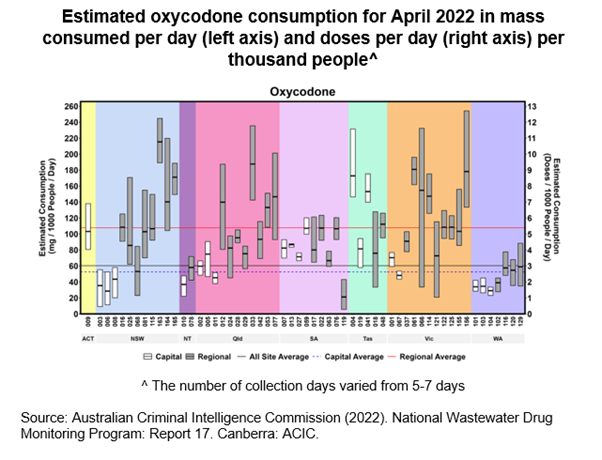
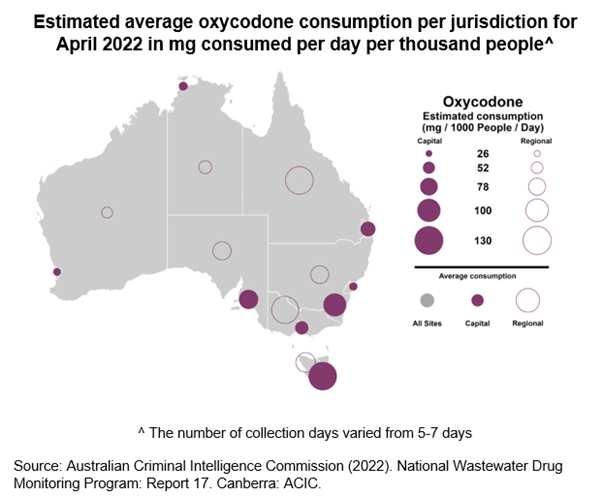
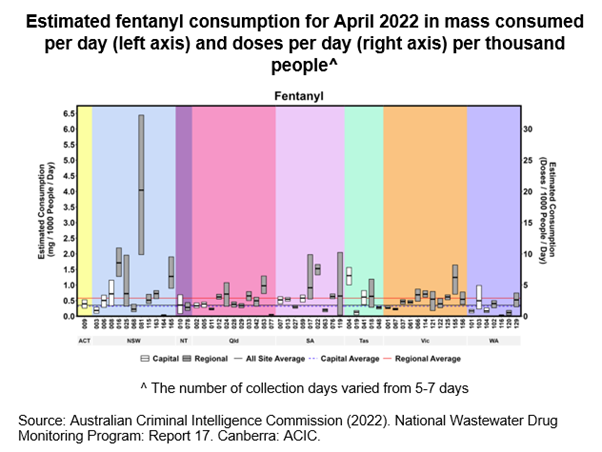
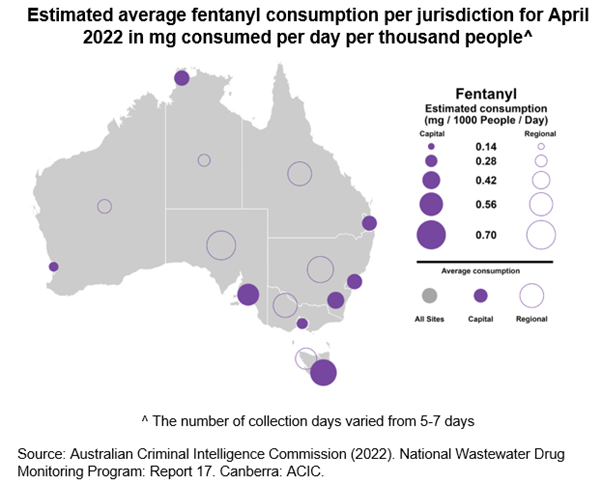
Source: Australian Criminal Intelligence Commission (2022). National Wastewater Drug Monitoring Program: Report 17. Canberra: ACIC.
† This FAQ uses data from the National Wastewater Drug Monitoring Program, which measures the major metabolite of oxycodone and fentanyl, two legally prescribed pharmaceuticals with abuse potential.

